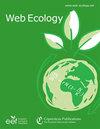金合欢在欧洲西南部的入侵、生态影响及防治综述
IF 2.4
3区 环境科学与生态学
Q2 ECOLOGY
引用次数: 9
摘要
摘要南欧最多产的金合欢(Acacia dealbata, A. melanoxylon和A. longfolia)正在其最西部地区迅速蔓延:葡萄牙和西班牙西北部,那里已经建立了具有入侵潜力的同属植物。我们对欧洲南部的金合欢入侵进行了书目检索,并利用伊比利亚的金合欢分布和非生物参数的空间数据来检验非生物因素对金合欢入侵的影响。根据我们的研究结果,在伊比利亚,A. dealbata和A. melanoxylon似乎受到土壤pH值高(pH cac2 > 5.5)、频繁的霜冻(>21 ~ 40 d yr - 1)和年降水量低(低于1000 mm)的限制;长叶橐吾的数据不确定,而salignapap在最干燥和最温暖地区的中性土壤中。随着烧伤面积的增加,褐刺和黑梭梭所占的面积比例显著增加。在文献中,金合花的入侵性通常归因于其较高的繁殖和播种能力,以及通过其化感作用潜力产生的本地排斥;与根瘤菌的共生乱交;highenvironmental可塑性;适应被烧毁、被砍伐和资源贫乏的土地。然而,目前尚不清楚金合欢是如何在西尼伯利亚如此具有侵略性的,那里有大量具有相似生态特征的本地豆科灌木(以及在其自然范围之外的入侵者)。入侵的金合欢可以改变水火状况、地上生物多样性和表层土壤特征(微生物群落、pH值、有机质和宏量营养素水平);然而,缺乏与成熟的伊比利亚豆科植物在这些和其他土壤特性(氮通量、微量营养素)方面的合理比较。由于一些金合欢在一定程度上由于敌人的释放而胜过伊比利亚豆科灌木,因此引入生物防治剂(如葡萄牙的长叶金合欢)可用于入侵控制。本文章由计算机程序翻译,如有差异,请以英文原文为准。
Invasiveness, ecological impacts and control of acacias in southwestern Europe – a review
Abstract. The most prolific acacias in southern Europe (Acacia dealbata, A. melanoxylon and A. longifolia) are rapidly
spreading in its westernmost area: Portugal and NW Spain, where congeners
with invasion potential are already established. We performed a
bibliographic search of acacia invasions in southern Europe and used spatial
data on acacia distribution and abiotic parameters in Iberia to check the
influence of abiotic factors on acacia invasion. According to our results,
in Iberia A. dealbata and A. melanoxylon seem limited by high soil pH (pH CaCl 2 > 5.5 ),
frequent frosts ( >21 to 40 d yr −1 ) and low annual
precipitation ( to 1000 mm); data were inconclusive for A. longifolia, while A. saligna
prefers neutral soils in the driest and warmest areas. The percentage of
area occupied by A. dealbata and A. melanoxylon increases significantly with the percentage of burnt
surface. In the literature, acacias' invasiveness is usually attributed to
their high resprouting and seeding capacity and to native exclusion through
their allelopathic potential; symbiotic promiscuity with rhizobia; high
environmental plasticity; and adaptation to burnt, cleared and resource-poor
land. However, it is unknown how acacias became so invasive in western
Iberia, where native Fabaceae shrubs with similar ecological traits (and
invaders outside their natural range) are abundant. Invasive acacias can
modify fire and water regimes, aboveground biodiversity, and topsoil
characteristics (microbial communities, pH, organic matter and
macronutrients levels); nevertheless, sound comparisons with mature stands
of Iberian legumes for these and other soil properties (N fluxes,
micronutrients) are lacking. As several acacias outcompete Iberian Fabaceae shrubs
partly thanks to enemy release, the introduction of biocontrol agents (as
for A. longifolia in Portugal) can be useful for invasion control.
求助全文
通过发布文献求助,成功后即可免费获取论文全文。
去求助
来源期刊

Web Ecology
Agricultural and Biological Sciences-Ecology, Evolution, Behavior and Systematics
CiteScore
4.60
自引率
0.00%
发文量
6
审稿时长
17 weeks
期刊介绍:
Web Ecology (WE) is an open-access journal issued by the European Ecological Federation (EEF) representing the ecological societies within Europe and associated members. Its special value is to serve as a publication forum for national ecological societies that do not maintain their own society journal. Web Ecology publishes papers from all fields of ecology without any geographic restriction. It is a forum to communicate results of experimental, theoretical, and descriptive studies of general interest to an international audience. Original contributions, short communications, and reviews on ecological research on all kinds of organisms and ecosystems are welcome as well as papers that express emerging ideas and concepts with a sound scientific background.
 求助内容:
求助内容: 应助结果提醒方式:
应助结果提醒方式:


